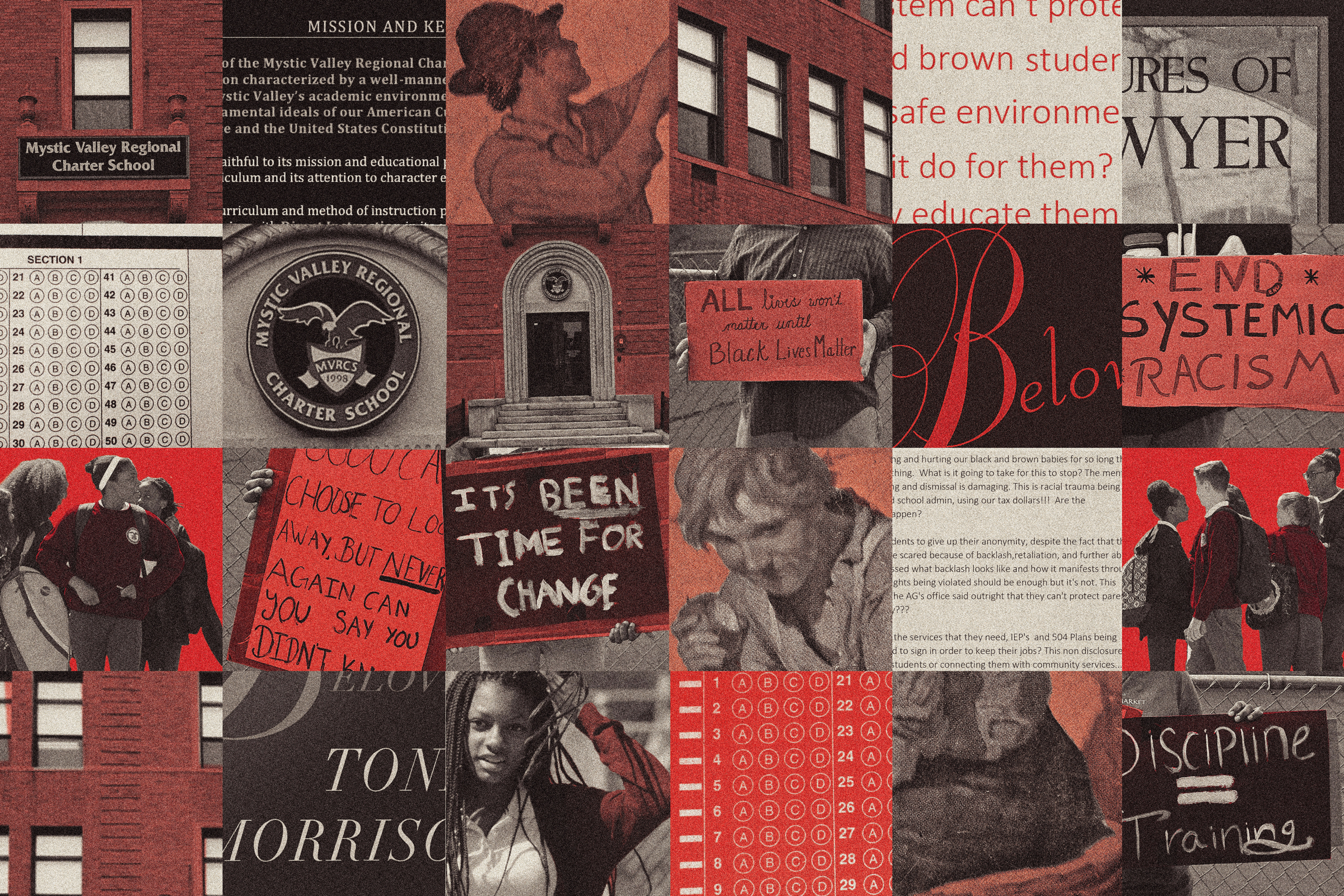Eric Henry couldn’t believe what the 5th-graders at his triplets’ school were being assigned to read. On Jan. 31, the electrical engineer and Navy veteran fired off an email to a group of fellow parents and activists in the Boston suburb of Malden. “Remote learning has given us added insight into what stands for instruction based on American Culture!” Henry wrote. “The banning of this text from the curriculum should be a plank in our platform.”
The book in question was The Adventures of Tom Sawyer, Mark Twain’s 1876 classic of American literature—a work approved by the state of Massachusetts as part of the public-school curriculum. But when Henry’s missive reached an employee at the agency that oversees Mystic Valley Regional Charter School, the official agreed with his complaint.
“This is horrible,” wrote Olympia Stroud, a program coordinator at the Massachusetts department of elementary and secondary education (DESE). “How long have these books been in the curriculum?” Stroud forwarded the concerns to a supervisor, Benie Capitolin, who called the matter “heartbreaking.” “If our system can’t protect Black and brown students from unsafe environments,” Capitolin wrote, “how can it possibly educate them?”
For 23 years, Mystic Valley’s academic record has been undeniable. Its students are disproportionately lower-income kids from communities of color, yet its test scores and graduation rates routinely rank among the state’s best. Charter-school rankings place it in the top percentiles nationally. The school’s 1,500-person wait list is nearly as large as its K-12 enrollment, and attrition is so low that few students are admitted past kindergarten.
Under Massachusetts law, charter schools, which are publicly funded but privately operated, are supposed to be judged solely on their academic success, faithfulness to their charter and organizational viability. But Mystic Valley’s future as an institution is now in doubt because of an approach to teaching that has fallen out of fashion. The school’s educational mission focuses on “the fundamental ideals of our American Culture,” with an emphasis on the nation’s founding documents. As set out in its state-approved charter, it aims to “embrace the melting pot theory by highlighting our citizens’ and students’ commonality, not their differences.”
Yet to avoid perpetuating racism, many educators, administrators and parents now believe it’s insufficient to ensure that everyone is treated the same. A few years ago, as national debates about racism and history intensified, DESE added a new “cultural responsiveness” standard to its evaluation of charter schools, defined as “an approach to viewing culture and identity as assets” in order to “acknowledge and actively draw upon diverse backgrounds [and] identities.”
Read More: Inside the Fight Over What Kids Learn About America’s History.
To Mystic Valley, this new criterion seemed like an attempt to impose race consciousness on a proudly egalitarian school. When administrators expressed concerns that its charter was incompatible with the new cultural standards, the state insisted there was no issue. Yet in May, when regulators conducted an interim performance review, they informed the school that it was only “partially conducive to learning” because of its approach to culture and identity. A draft report issued in September marked the school as not fully meeting the new standard. Mystic Valley has sued the state over the cultural-responsiveness criteria, which it fears could put its charter in jeopardy.
Such reviews are supposed to be unbiased and free of outside influence. But according to a trove of emails the school obtained through a public-records lawsuit, DESE employees were secretly coordinating with the school’s critics, including the Henrys, the NAACP and local racial-justice activists unconnected to the school.
The critics appeared to strategize with the state officials to go after Mystic Valley. In their emails, the activists advocated a “stealth approach,” using “cloak and dagger” tactics. And DESE went along, adding employees to the review team who were concerned about the school’s racial climate, then deliberately delaying the review for months to allow parents to submit official complaints. When none materialized, the department created informal focus groups that they packed with the same complaining activists, then incorporated the groups’ feedback into its report, the documents show. In another email, Stroud praised the activists for their work to “help expose Mystic Valley.” (DESE declined to comment, citing the school’s pending lawsuit. The state attorney general’s office is also reviewing complaints of alleged racial discrimination at Mystic Valley, according to a spokeswoman.)
Other parents at the school, many of them working-class people of color who see it as their child’s best chance at success, are disturbed by the conflict. Many are terrified Mystic Valley will be forced to close. “We have always been evaluated with flying colors,” says Alex Dan, the school’s director, a former English teacher and swimming coach. But now, “there’s this vague mandate to follow a new approach that we feel is the opposite of what’s made us so successful as a school and wonderful as a country.”
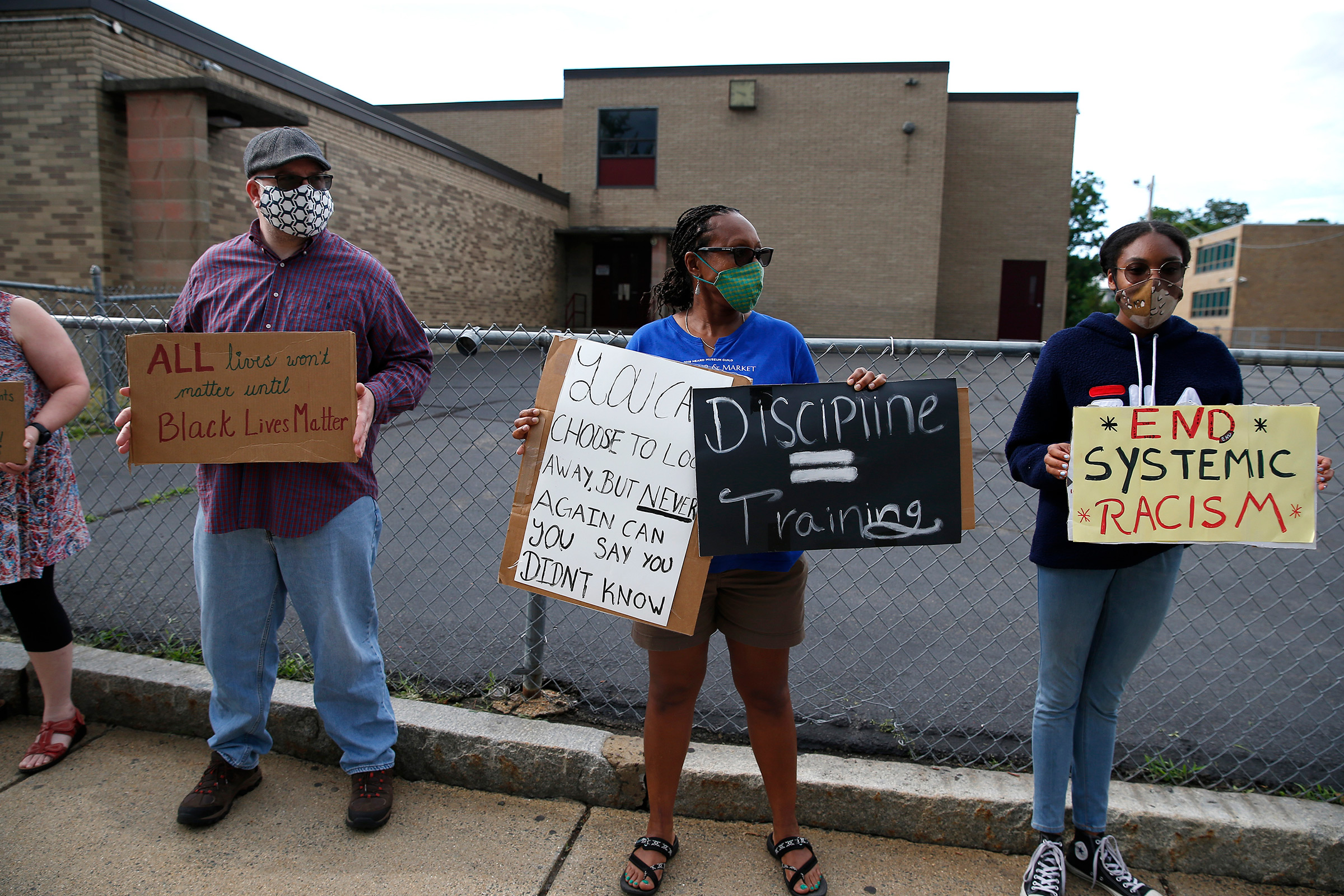
The teaching of race in American schools has become a front-burner political issue. New laws regulating curricula have passed from coast to coast, and education was a dominant topic in Virginia’s recent gubernatorial election, which saw Republican candidate Glenn Youngkin ride a critique of state policy to an upset. Yet the debate has generated more heat than light, with conservatives charging that students are being brainwashed with “critical race theory” while liberals insist they merely want the teaching of history to better reflect the country’s complicated past. The Mystic Valley controversy helps illustrate that both arguments are misleading, or at least incomplete. What’s really at issue is not the past but the future: how the next generation of Americans are taught to regard their own identities in relation to society and their peers.
In Virginia, political attention focused on a white mother upset that her high schooler was assigned Toni Morrison and a sexual-assault case apparently unrelated to bathroom-gender policies. But parents in the state have also protested the reorienting of the state’s social-studies curriculum to focus on “antiracism”; an attempt to eliminate advanced math classes in the name of equity; new “social emotional learning” standards that ask children to contemplate their racial and gender identity beginning in elementary school; and the elimination of admissions testing at Thomas Jefferson, an Alexandria high school ranked No. 1 in the nation. Elsewhere in Massachusetts, Boston’s prestigious public “exam schools” have sought to eliminate admissions tests as discriminatory, a move also under way in liberal cities like New York and San Francisco.
These are potentially seismic shifts to the public educational system. None was put to a public vote. As in Mystic Valley’s case, the push for change has as often come from activists and bureaucrats as from parents or politicians. Whether critical race theory is the source of the changes is a red herring. “Call it whatever you want, it’s just bad ideas,” says Asra Nomani of the anti-CRT group Parents Defending Education. An Indian American liberal who grew up in West Virginia, Nomani founded a parents’ group to protest the changes at Thomas Jefferson, from which her son graduated this year. “We’re all in agreement as a nation that we have to dismantle the old hierarchy of human value that perpetuated discrimination and racism,” she says. “But these ideologues want to replace it with a new hierarchy of human value that’s racist, intolerant, shaming and bigoted. What they are doing is messing at the earliest age with a child’s sense of self.”
What Mystic Valley’s proponents and critics agree on is that its colorblind approach is at the heart of the controversy. “Their view is, we’re a melting pot, there are no racial differences, no cultural differences—essentially, as long as you accept white culture, you’re fine,” says Greg Bartlett, secretary of the local NAACP branch. Students of color may be getting good test scores, but they are not safe, he says. “In my judgment, the school isn’t overtly racist, but it’s clear there’s a lot of hurt going on.”
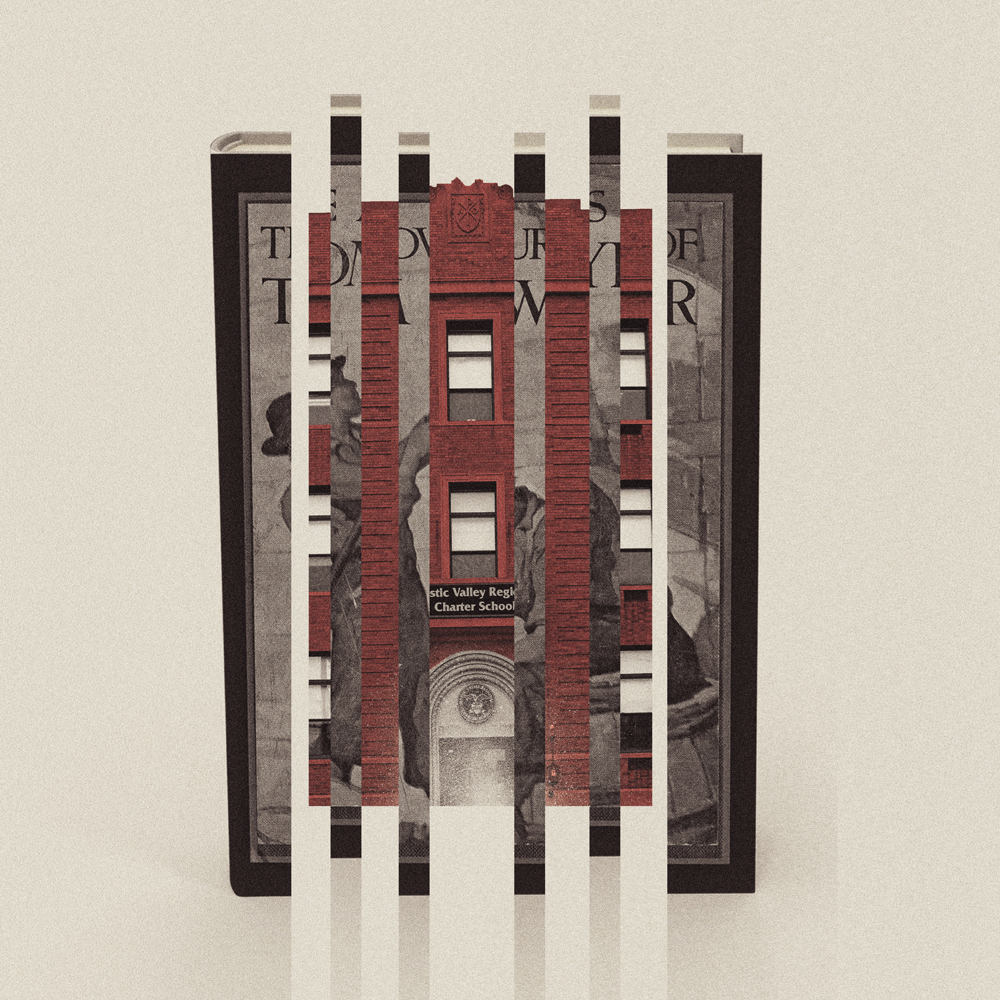
For as long as there has been an America, scholars have debated the tension between assimilation and multi-culturalism, race neutrality and race consciousness. How to make a single, neutral set of rules for a nation whose very Constitution deemed some inhabitants to have a fraction of the personhood of others—a land founded on immigration, genocide and bondage, held together not by an identity but an ideal.
In recent years, many Americans have become aware that “equal” rules can have unequal outcomes. A textbook example occurred at Mystic Valley in 2017. To ensure parity among students, the school has a strict dress code; it mandates uniforms and forbids makeup, jewelry and other forms of ornamentation. But the policy against hair extensions had a disproportionate impact on Black girls, 15-year-old twins Mya and Deanna Cook pointed out. For them, box braids weren’t an indulgence; they were a way to transition from treated to natural hair.
School officials say the controversy was merely a misunderstanding. “As a middle-aged white guy, despite having done civil-rights work for 30 years, I was ignorant to the importance of hair extensions to women of color,” says Howard Cooper, a liberal Boston lawyer who’s argued civil-rights cases for the ACLU and is now representing Mystic Valley in its lawsuit against the state. Once the school understood the rule’s disproportionate effect, Cooper says, it voluntarily changed the policy, expanded the role of its civil-rights coordinator and mandated diversity training for all employees. The following year, its charter was renewed without incident.
Make sense of what matters in Washington. Sign up for the D.C. Brief newsletter.
But Mya Cook, now a 20-year-old college student, says this is a sanitized version of the story. In multiple meetings, she says, the twins broke down in tears as an all-white group of Mystic Valley administrators insisted the rule wasn’t racist because it applied to everyone. “They were totally in denial—they didn’t want to understand,” recalls Cook, who was banned from prom and extracurricular activities and received multiple detentions. It was only after the state attorney general’s office intervened, issuing a letter stating that it considered the policy unlawful and discriminatory, that the school relented.
From Mystic Valley’s perspective, this was the end of the problem. But for many parents, students and alumni, it was just the beginning—an incident that led them to see Mystic Valley’s approach to race in a new way. The concerns gathered steam during COVID-19, when the school offered fully in-person instruction, unlike other public schools in the area, and a Facebook group for at-home families became a forum for previously unaired complaints.
After the May 2020 murder of George Floyd, a group of alumni circulated a petition to “Make MVRCS an Actively Anti-Racist School,” urging it to “restructure the mission statement and handbook to address issues of systemic discrimination.” At a virtual meeting of the school’s board of trustees on June 8, 2020, parents and alums demanded to know why the school hadn’t responded to the tragedy or denounced Facebook posts by its co-founder and former board chair Neil Kinnon, a former Democratic Malden city councilman who shared a Wall Street Journal op-ed denying police racism. The board members announced no action in response to the complaints.
Finally, on June 16, Dan, Mystic Valley’s director, wrote a letter to the school’s families. “We recognize that there has been and continues to be an unacceptable tolerance of racism by sections of our society,” he wrote. “It is our sincere hope that the current activism will yield true and productive results and lead to the fair and just treatment of those who have and continue to suffer for no other reason than the color of their skin.”
For many parents, this was insufficient. “All these multibillion-dollar industries were finally saying ‘Black Lives Matter’—even NASCAR!” says Zinah Abukhalil-Quinonez, whose daughter was in first grade at the time. “Why couldn’t they stand up and say those words?” A Puerto Rican–Palestinian social worker, Abukhalil-Quinonez was shocked to discover that the school didn’t celebrate Black History Month. Her concerns deepened as she monitored her daughter’s virtual lessons. In one second-grade homework assignment, a multiple-choice answer about Harriet Tubman identified her as “a conductor on the underground railroad,” as though she were merely operating a train. Abukhalil-Quinonez says her daughter is now much happier at her local school. “They talk about inclusion, they talk about feelings—it’s not just memorization.”
Mystic Valley’s detractors note that students of color are disciplined at higher rates than white students are and complain that the faculty lacks diversity. The staff is 87% white, compared with 43% of students. (At the six surrounding districts from which Mystic Valley draws, the staff ranges from 89% to 97% white.) To substantiate their complaints about the school’s climate, critics circulated 12 anonymous testimonials from racial and gender minorities, which raised issues ranging from bullying to microaggressions. One Black student said a teacher called her a “token” while reading To Kill a Mockingbird in seventh grade; another said an eighth-grade teacher repeatedly mixed up Black students. A bi-sexual student was disturbed by a teacher’s evident discomfort with the “Call Me Maybe” music video, which ends with a gay flirtation, while another queer student complained about not being allowed to write a paper about role models on Ellen DeGeneres. “We were forced to comply and assimilate, thus abandoning my values and traditions in favor of that of white nationalist propaganda,” wrote an immigrant student who was punished for refusing to say the Pledge of Allegiance. (The activists say these testimonials are just a small subset of the statements they collected, which they couldn’t publish for privacy reasons. I was allowed to view the larger database to verify its existence on the condition that I not quote from it directly; it contains 127 accounts of alleged mistreatment that students say they witnessed or experienced, dating back to 2007.)
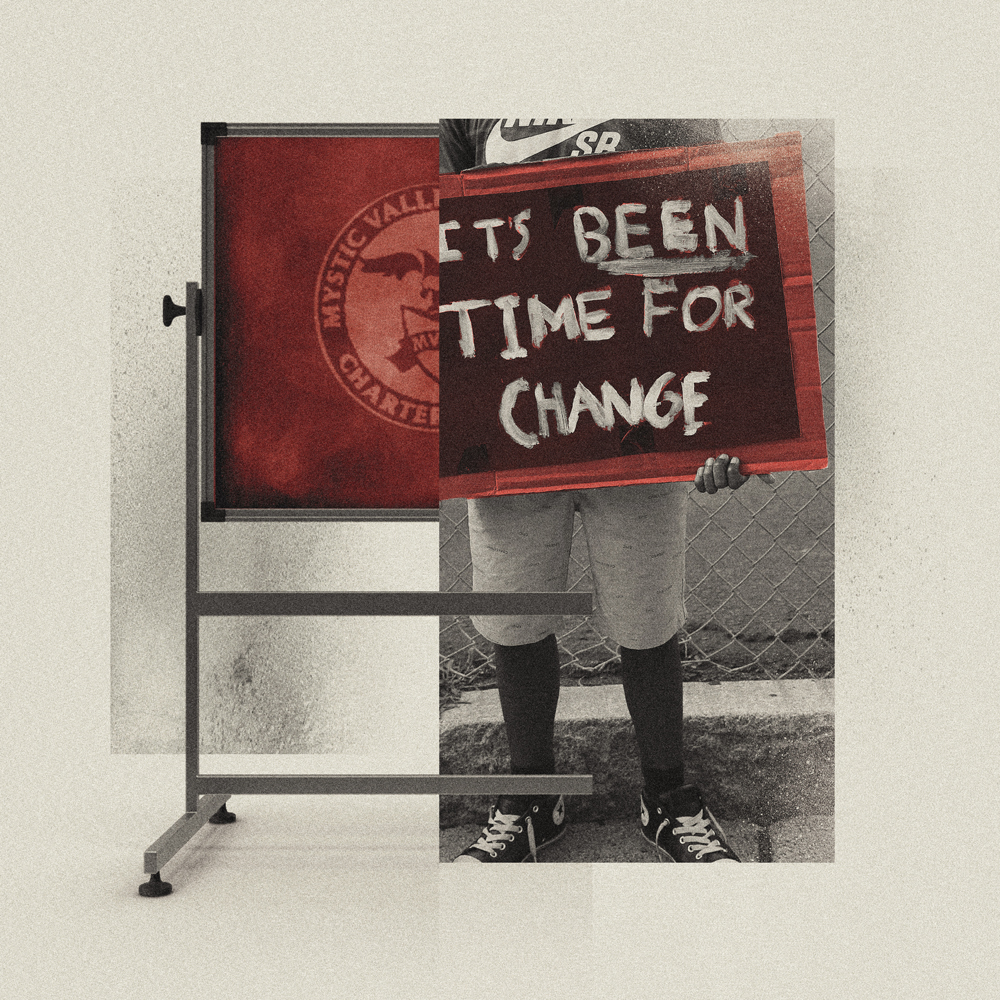
For many years, Eric Henry was one of Mystic Valley’s biggest boosters. “My wife would ride around when she was pregnant saying, ‘That’s where I’m going to send my kids,’” recalls Henry, who is Black. As a military man, he -especially loved the school’s strict discipline. From the time the triplets started kindergarten, he was an enthusiastic member of the school community, serving on the parent-teacher organization, attending board meetings and even volunteering on Kinnon’s political campaigns.
But the Henrys began having reservations when a seventh-grade teacher persistently misspelled Dewayne’s name. Then, in eighth grade, Thora had a conflict with an English teacher that spiraled out of control. She was called “insubordinate” and accused of creating “drama,” charges she only ever saw directed to Black students. “My white classmates could be standing right there and I wouldn’t even be doing anything, but I would be the one who got in trouble,” says Thora, 16, who left Mystic Valley and now attends Malden High.
Eric Henry says he once embraced the school’s philosophy but now finds it abhorrent. “Now, when I read them talking about their steadfast commitment to this concept of ‘American culture,’ it makes me cringe to no end,” he says. “I hear people complain about critical race theory, but from my understanding we need more of it. Isn’t it just the truth to say there’s systemic racism in America? I think, in this society, we fear those facts that are from the perspective of the victim.”
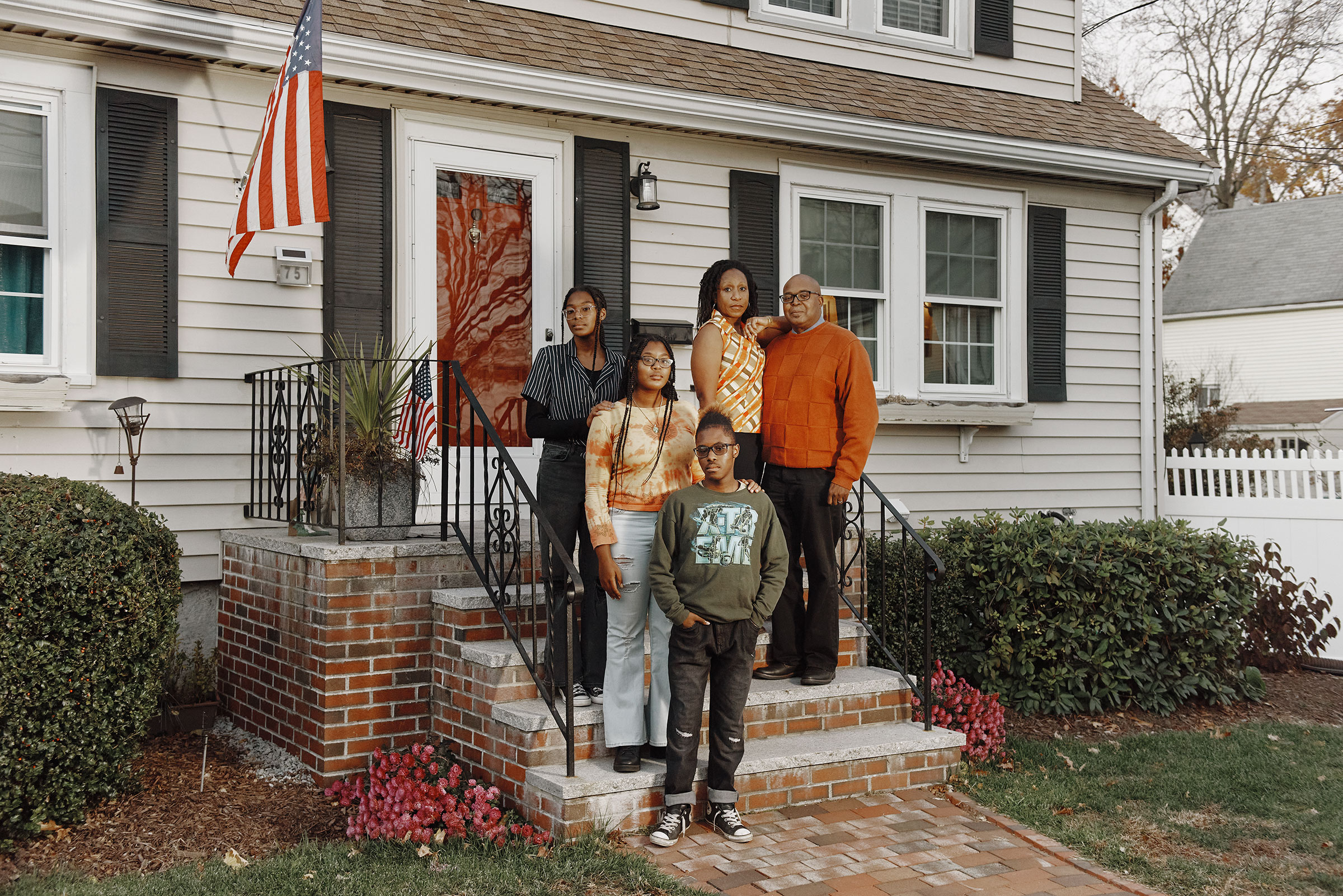
The controversy over assigning Mark Twain originated with Henry’s friend Saeed Coates, a Black real estate investor with three daughters at Mystic Valley. Coates had never read Tom Sawyer before his eldest brought it home last winter. Perusing it, he was disturbed by the book’s repeated use of the N word. “My fifth-grader should not be made to feel uncomfortable,” Coates says. “I think it’s insane they’re exposing fifth-graders to ethnic slurs.” No children of other races, he pointed out, were subjected to a barrage of racist insults in their class readings—only Black children.
Coates complained to the school, which pulled the book temporarily, replaced it with a sanitized version and supplemented it with a lesson on racism, he says. Teachers also worked to put the book in context, describing the conditions Black slaves faced in 1840s Missouri and pointing out that Twain was an abolitionist. But Coates was furious that the book stayed in the curriculum: “It means nothing to say, ‘Racism’s bad, now let’s get back to the n—-r book.’” The Coateses are considering private school instead, and he says they also may sue for discrimination.
The questions underpinning the Mystic Valley controversy cut to the core of public education: What does it mean to prepare children to be citizens of the United States? To take their place in society? To be considered “educated”? And as society changes, when and how should those standards change in response?
Andre DiFilippo, who attended Mystic Valley from kindergarten through his graduation in 2015, believes the school is failing to educate its students about the social realities that lurk beyond the pages of their textbooks. A son of Italian immigrants, DiFilippo was senior-class president and a member of the first generation in his family to attend college. When he got to the University of Massachusetts Lowell, he found he was better prepared than many classmates for the rigors of higher education. What he wasn’t prepared for was the gradual realization that he was bisexual. “When you force people to deny their identity—their queerness, their Blackness, their womanhood, their culture—when you actively suppress that, it takes a toll on people’s mental health,” he says. “It takes a lot of people years of unpacking post–Mystic Valley to figure out why they’re so unhappy.”
“Life, liberty—there’s one more, the pursuit of something. Who can tell me what it is?” It’s almost dismissal time for Ms. Gregory’s fourth-grade class, and the students sit in neat rows behind plastic COVID barriers as she roams the room looking for raised hands. The school draws inspiration from the Core Knowledge approach invented by E.D. Hirsch Jr., a scholar whose heavily scripted curriculum is controversial but has been shown to achieve high test scores. “Susanna? Yeah, the pursuit of happiness!” Gregory says. “All right, let’s do the next one. Why did George Washington cross the Delaware?”
Dan, the director, stands by the classroom door, observing. He knows Mystic Valley is not for everyone. “A lot of people look at this and say, ‘That’s not what I want for my kids,’” he says. But for other students, it can be a lifeline. Growing up, Dan, who declined to disclose his racial background, attended Montessori school in Lansing, Mich., where he struggled with the experiential, student-centered style of instruction. “I was a student who needed to be put in a more structured environment with more stringent expectations to maximize my potential,” he says. In Mystic Valley, where he started as a substitute in 2005, he found the structure he craved. “I always felt that allowing for differences in standards,” says Dan, who has two children in the school, “was giving up on students who were capable of so much more.”
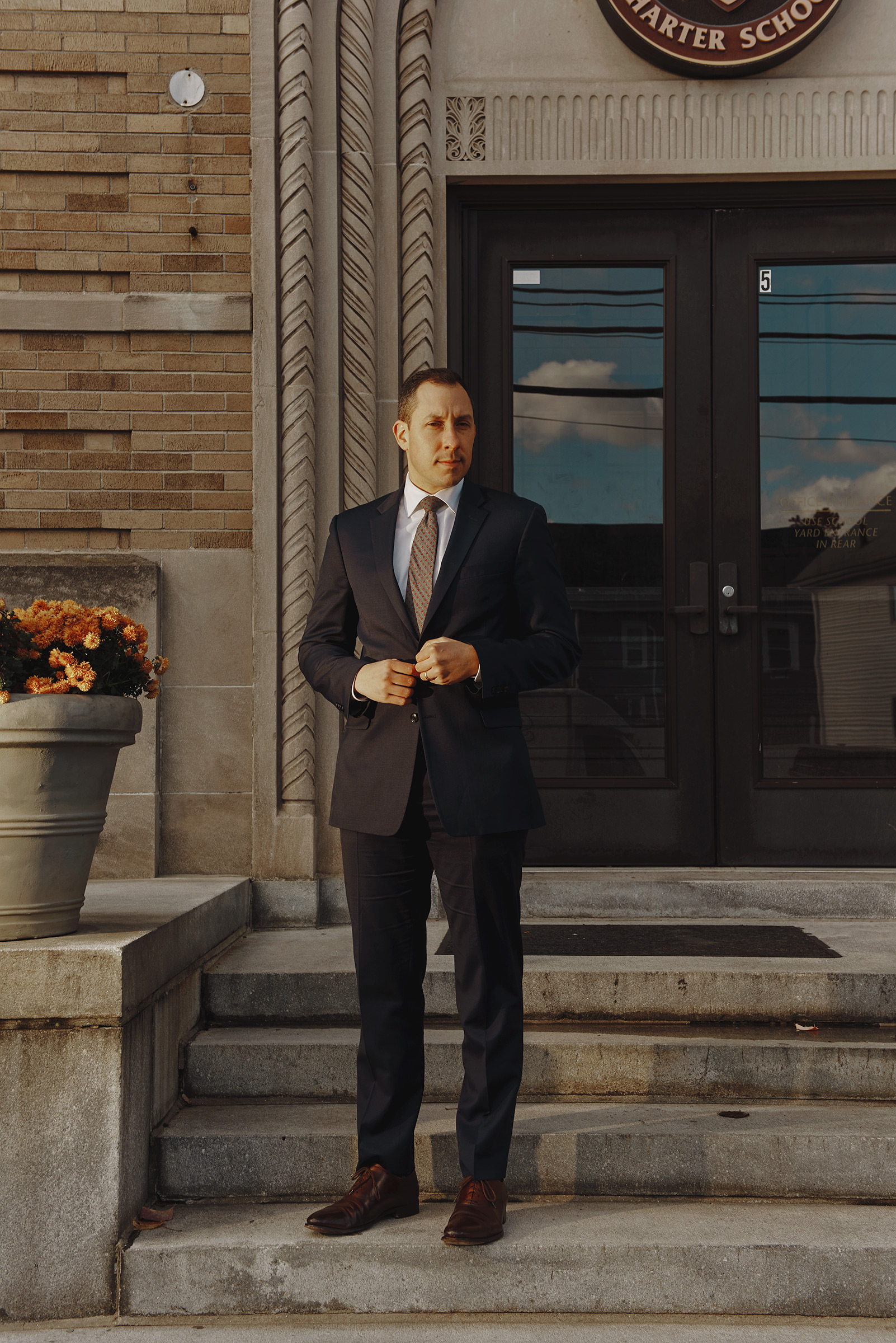
The point of charter schools, Dan notes, is to offer pedagogical choice to all students, not just those who can afford private schools. It baffles him that people call Mystic Valley racist when it’s producing better academic outcomes for minority students. “The fundamental premise of charter-school education is equalizing the playing field for kids from all backgrounds,” he says. “When you look at the data, it tells a vastly different story than what this small, vocal group of critics wants to claim.”
Read More: The Education-Reform Movement Has Failed America.
Most Popular from TIME
This is what confounds Mystic Valley’s satisfied customers: What better way to fight injustice than to close the achievement gap and make better futures possible for children of color? “One of the things that’s most ironic to me is Mystic Valley being labeled conservative when it has some of the most audacious goals for student achievement,” says Brett Chevalier, a self-described liberal whose daughters are in eighth and third grade at the school. “I see it as just the opposite—they’re so idealistic, so dedicated to equality. The problems of the Founding Fathers aside, America is founded on the idea that anybody can come here and make it.” An MIT-trained scientist originally from lily-white rural Canada, Chevalier especially loves the diversity his children are exposed to at Mystic Valley.
Fellow parents say the school’s quality is inextricable from its monocultural approach. “The way the school handles it, the idea we’re all the same—I wish I had that as a kid growing up,” says Jeff Chau, a son of Chinese immigrants who works in IT. “My wife and I came from low-income families. I didn’t want to be labeled and singled out, but I was. I didn’t get to be the funny kid, the nice kid, the smart kid—it was always the poor kid, the Chinese kid, the short kid.”
“The poor, Chinese, short kid,” his wife Karen Chau chimes in. “I didn’t have a lot of self-esteem growing up because of who I was. We’ve progressed so far in this country, I don’t think my son will ever have to go through the type of racism I experienced in inner-city Boston.”
The families I spoke with at Mystic Valley spanned the political as well as socioeconomic spectrum, from conservatives relieved their kids aren’t being turned against them to liberals who relish its egalitarianism and diversity. Tessema Ashenafi, an analyst at a financial company and Ethiopian immigrant, was concerned by the news reports about the school and asked his Black 13-year-old twins if anything bad had happened to them. He concluded things were being blown out of proportion. “There are some bad apples everywhere you go, but in my perspective this has been exaggerated by people who are trying to bring down the school,” he says. “I’m a beneficiary of this country. It has done a lot for me, much more than my birth country.”
Ashenafi isn’t in denial about racism; he says he had to labor, sometimes painfully, to gain the acceptance of his white neighbors and co-workers. But it is this sort of integration, he contends, that makes people able to live in harmony. He sees the controversy at Mystic Valley as a product of America’s broader divisions. “Everyone is very sensitive, very extreme,” he says. “I’m trying to teach my kids not to be too sensitive and to put scenarios in perspective.”
A few weeks ago, Halloween was canceled at the public-school district in nearby Melrose, Mass. The superintendent announced that generic “fall celebrations” would better advance the goals of “equity and inclusion.” A backlash ensued, and Halloween was subsequently celebrated with such gusto at Mystic Valley that some liberal parents suspected it was an intentional swipe. It was an apt distillation of the vexing question facing American education today: to purge children’s worlds of the things not everyone can share, or expose them all to the same thing, whether or not they can relate to it? And is there any neutral ground between the extremes?
The answers to these questions may be existential for Mystic Valley. The school’s lawsuit against DESE is pending, and the state board recently denied it a waiver from the new cultural-responsiveness criteria. Several Democratic state legislators are pressuring the school to change. Mystic Valley officials believe the internal DESE emails they uncovered prove that the fix is in and the state is determined to find a pretext on which to revoke its charter, which is up for renewal in 2023. It would be a brutal irony, they say, if an institution with a track record of improving outcomes for children of color is shut down in the name of antiracism.
Rita Mercado, a Filipino-American government lawyer who lives in Melrose, is among the parents who believe in Mystic Valley’s vision of inclusion. She sees a group of children from diverse backgrounds who are learning to get along without taking anyone’s identity for granted. At an “American heritage” performance her son took part in when he was in kindergarten, “seeing 100 kids of different nationalities singing ‘This Land Is Your Land,’ I remember thinking, This is what I envision America to be.”
Mercado’s son, now 7, wasn’t aware of the town’s Halloween kerfuffle when he wrote a letter to his pen pal earlier in the fall. Do you celebrate Halloween, the second-grader wanted to know, and if so, what do you do? Reading it, Mercado’s heart swelled with pride. This sort of curiosity was instinctive to him: he knew from school that not everyone celebrates Christmas, or Hanukkah, or Diwali, so it made sense to ask. “Score one for these kids being more woke than me!” she says. It’s the adults who are still trying to figure it all out.—With reporting by Julia Zorthian/New York
Correction, Nov. 30:
The original version of this story misstated Andre DiFilippo’s background. He belongs to the first generation in his family to attend college, but was not the first to attend. The original version of the story also misstated Tessema Ashenafi’s profession. He is an analyst for a financial company, not a financial analyst.
More Must-Reads From TIME
- The 100 Most Influential People of 2024
- The Revolution of Yulia Navalnaya
- 6 Compliments That Land Every Time
- What's the Deal With the Bitcoin Halving?
- If You're Dating Right Now , You're Brave: Column
- The AI That Could Heal a Divided Internet
- Fallout Is a Brilliant Model for the Future of Video Game Adaptations
- Want Weekly Recs on What to Watch, Read, and More? Sign Up for Worth Your Time
Write to Molly Ball/Malden, Mass. at molly.ball@time.com
